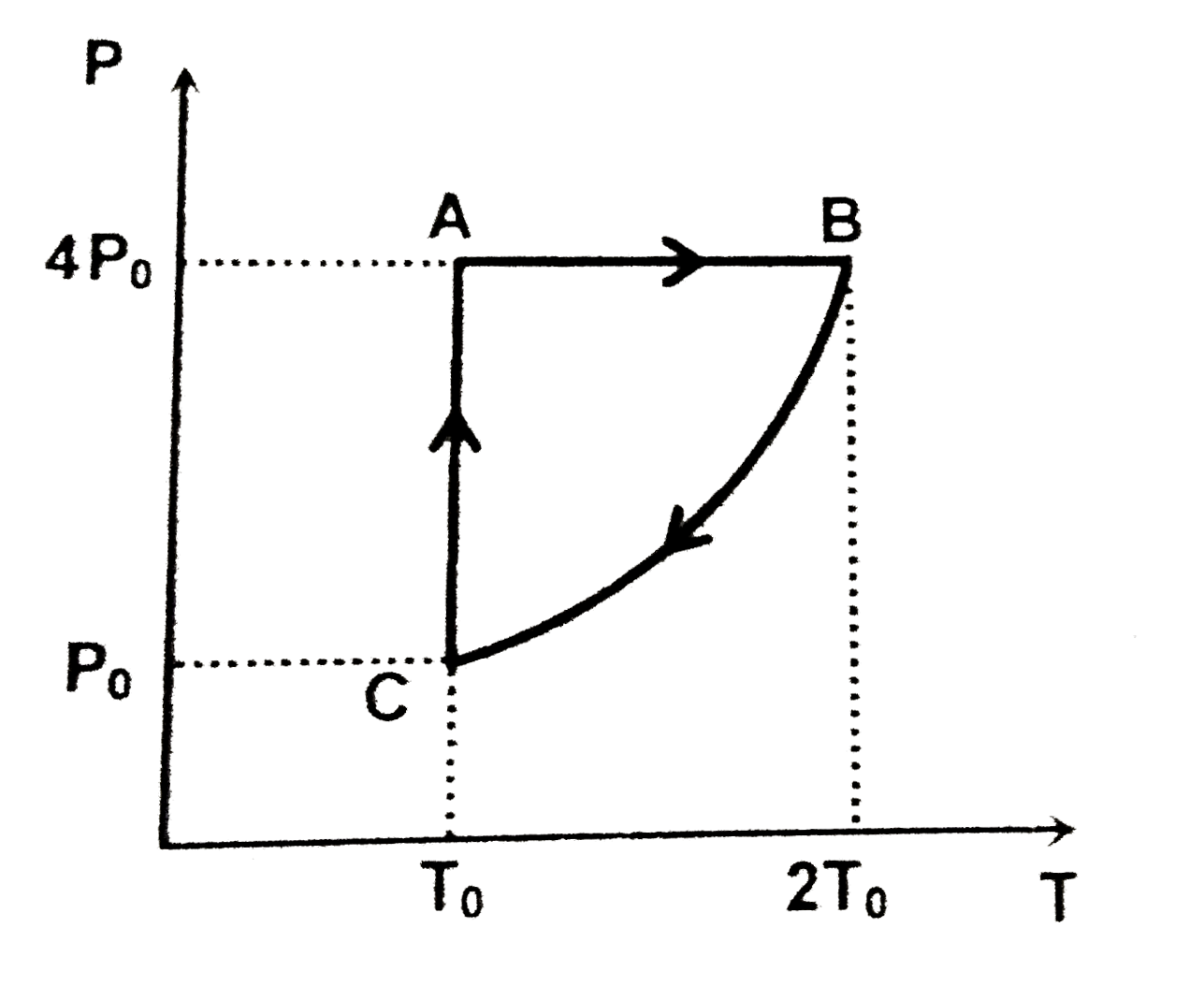A rod of length l with thermally insulated lateral surface consists of material whose heat conductivity coefficient varies with temperature as k=a/T, where a is a constant. The ends of the rod are kept at temperatures T1andT2. Find the function T(x), where x is the distance from the end whose temperature is T1.
The correct Answer is:A, B
To solve the problem, we need to find the temperature distribution T(x) along the length of a rod with varying thermal conductivity. The thermal conductivity k is given by k=aT, where a is a constant, and the ends of the rod are maintained at temperatures T1 and T2.
1. Understanding the Heat Flow:
- The rod has a length L and is insulated on the sides, meaning heat can only flow along its length. At steady state, the heat current dQdt is constant.
2. Setting Up the Heat Current Equation:
- Consider an elemental length dx at a distance x from the end at temperature T1. The temperature at this point is T, and at the other end of the element, it is T+dT.
- The heat current through this elemental length can be expressed as:
dQdt=kAdTdx
- Here, A is the cross-sectional area of the rod.
3. Substituting for k:
- Since k=aT, we can substitute this into the heat current equation:
dQdt=aTAdTdx
4. Setting the Heat Current Equal:
- Since the heat current is constant, we can denote it as I:
I=aTAdTdx
5. Rearranging the Equation:
- Rearranging gives us:
I⋅T=aAdTdx
- Rearranging further, we have:
dTdx=ITaA
6. Integrating the Equation:
- To find T as a function of x, we can separate variables and integrate:
∫dTT=IaA∫dx
- This leads to:
lnT=IaAx+C
- Where C is the integration constant.
7. Finding the Constant of Integration:
- We can express C using the boundary condition at x=0 where T=T1:
lnT1=C
- Thus, we have:
lnT=IaAx+lnT1
8. Exponentiating to Solve for T:
- Exponentiating both sides gives:
T=T1eIaAx
9. Using the Boundary Condition at x = L:
- At x=L, T=T2:
T2=T1eIaAL
- From this, we can solve for I:
IaA=lnT2T1L
10. Final Expression for T(x):
- Substituting back into the equation for T:
T(x)=T1elnT2T1Lx
- This simplifies to:
T(x)=T1(T2T1)xL
Final Answer:
T(x)=T1(T2T1)xL
- The rod has a length L and is insulated on the sides, meaning heat can only flow along its length. At steady state, the heat current dQdt is constant.
- Consider an elemental length dx at a distance x from the end at temperature T1. The temperature at this point is T, and at the other end of the element, it is T+dT.
- The heat current through this elemental length can be expressed as:
dQdt=kAdTdx
- Here, A is the cross-sectional area of the rod.
- Since k=aT, we can substitute this into the heat current equation:
dQdt=aTAdTdx
- Since the heat current is constant, we can denote it as I:
I=aTAdTdx
- Rearranging gives us:
I⋅T=aAdTdx
- Rearranging further, we have:
dTdx=ITaA
- To find T as a function of x, we can separate variables and integrate:
∫dTT=IaA∫dx
- This leads to:
lnT=IaAx+C
- Where C is the integration constant.
- We can express C using the boundary condition at x=0 where T=T1:
lnT1=C
- Thus, we have:
lnT=IaAx+lnT1
- Exponentiating both sides gives:
T=T1eIaAx
- At x=L, T=T2:
T2=T1eIaAL
- From this, we can solve for I:
IaA=lnT2T1L
- Substituting back into the equation for T:
T(x)=T1elnT2T1Lx
- This simplifies to:
T(x)=T1(T2T1)xL
T(x)=T1(T2T1)xL
Topper's Solved these Questions
- CALORIMETRY & HEAT TRANSFERBOOK - DC PANDEY ENGLISHCHAPTER - CALORIMETRY & HEAT TRANSFEREXERCISE - Level 2 More Than One Correct
5 Videos
- BASIC MATHEMATICSBOOK - DC PANDEY ENGLISHCHAPTER - BASIC MATHEMATICSEXERCISE - Exercise
13 Videos
- CALORIMETRY AND HEAT TRANSFERBOOK - DC PANDEY ENGLISHCHAPTER - CALORIMETRY AND HEAT TRANSFEREXERCISE - Medical entrance s gallery
38 Videos
Similar Questions
Two bodies of different temperatures T1andT2 if brought in thermal contact, do not necessarily settle to the mean temperature (T1+T2)/2. Why?
View SolutionA rod of length l and cross sectional area A has a variable conductivity given by K=αT, where α is a positive constant T is temperatures in Kelvin. Two ends of the rod are maintained at temperatures T1 and T2(T1>T2). Heat current flowing through the rod will be
View SolutionThe coefficient of linear expansion 'α' of the material of a rod of length l0 varies with absolute temperature as α=aT−bT2 where a & b are constant. The linear expansion of the rod when heated from T1 to T2=2T1 is :-
View SolutionThe density of a rod of length L varies as ρ=A+Bx where x is the distance from the left end. Locate the centre of mass.

View SolutionA rod of length l and cross-section area A has a variable thermal conductivity given by K = α T, where α is a positive constant and T is temperature in kelvin. Two ends of the rod are maintained at temperature T1 and T2 (T1>T2). Heat current flowing through the rod will be
View SolutionTwo identical rods are made of different materials whose thermal conductivities are K1andK2. They are placed end to end between two heat reservoirs at temperatures θ1andθ2. The temperature of the junction of the rod is

View SolutionThe specific heat of a metal at low temperatures varies according to S=aT3, where a is a constant and T is absolute temperature. The heat energy needed to raise unit mass of the metal from temperature T=1K to T=2K is
View SolutionActivation energy (Ea) and rate constants (k1andk2) of a chemical reaction at two different temperature (T1andT2) are related by
View Solution
Two ends of a rod of uniform cross sectional area are kept at temperature 3T0 and T0 as shown. Thermal conductivity of rod varies as k=αT, (where α is a constant and T is absolute temperature). In steady state, the temperature of the middle section of the rod is
View Solutionx1andx2 are susceptibility of a Paramagnetic material at temperatures T1,KandT2K respectively, then
View Solution
